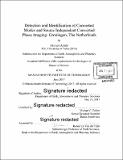Detection and identification of converted modes and source independent converted phase imaging : Groningen, The Netherlands
Author(s)
AlJishi, Ali Fuad
DownloadFull printable version (40.13Mb)
Other Contributors
Massachusetts Institute of Technology. Department of Earth, Atmospheric, and Planetary Sciences.
Advisor
Michael C. Fehler.
Terms of use
Metadata
Show full item recordAbstract
Passive seismic monitoring waveform data collected at the Groningen gas field contain many interesting events besides direct P- and S-arrivals. We begin by summarizing the station distribution at Groningen over time and discuss the earthquake catalog. We examine the converted arrivals in order to understand their nature. A combination of move-out analysis, raytracing and finite-difference simulations has revealed that the data contain converted phases from two shallow interfaces. We discuss the possibility of using the Source Independent Converted Phase Imaging method to image the position in the subsurface where these phases have been generated. We examine the limitations of that method for imaging the position of shallow interfaces such as the ones at Groningen. The station spacing required to apply the imaging method to the data is shown to correlate well with the estimated Fresnel Zone dimension for the interface depth and data frequency. By using a kinematic version of the Source Independent Converted Phase Imaging Condition, we can map those interfaces. The positions of the interfaces are shown to correlate well with the positions inferred by other means.
Description
Thesis: S.M., Massachusetts Institute of Technology, Department of Earth, Atmospheric, and Planetary Sciences, 2017. Cataloged from PDF version of thesis. Page 196 blank. Includes bibliographical references (pages 130-134).
Date issued
2017Department
Massachusetts Institute of Technology. Department of Earth, Atmospheric, and Planetary SciencesPublisher
Massachusetts Institute of Technology
Keywords
Earth, Atmospheric, and Planetary Sciences.